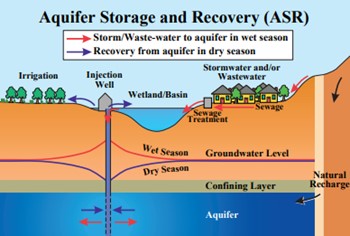Share:
OVERVIEW

Meeting increasing demands for water is a constant challenge and pressure to find both short-term and long-term water supply solutions has never been as urgent in many regions of the country as it is today. In areas experiencing water supply shortages and declining groundwater levels in aquifers, storing excess water resources underground to be use either at a later date or to manage the water quality of an aquifer can be an attractive solution for meeting current and future challenges posed by climate extremes such as droughts and flooding (in both short and long term), increased pressure on existing resources from population growth, competition for resources among various industries, and quantity and quality issues associated with current supplies.
Aquifer storage and recovery (ASR) and managed aquifer recharge (MAR) technologies are being used to address existing and new water demands. ASR/MAR can be as simple as shallow emplacement of excess surface water to complex deep injection, management, and recovery of water reservoirs, requiring careful design and implementation to achieve desired results.
Currently, many different types of water sources that are being used in ASR/MAR projects. Some systems utilize treated drinking water processed in low-water-demand periods (during winter months or at night) for use during high-demand periods in the summer. Others use stormwater, treated wastewater, or treated surface and groundwater from other aquifers when it is available. The aquifer into which the water is injected can be either fresh or saline. One of the key challenges to using these resources is achieving acceptance at the local level that these are viable, long-term water supplies that justify the expense associated with investigation and characterization, as well as development of the infrastructure needed to utilize them.
ISSUES HAMPERING ASR DEVELOPMENT OR USE
There are many successful ASR/MAR projects across the country and states and water resource managers believe that this technology can play a larger role in meeting future water demands. States face significant regulatory challenges in protecting groundwater quality and quantity, and improving regulatory efficiency and technical expertise in responds to a changing water supply paradigm that utilizes ASR/MAR. However, various groups have identified challenges facing drinking water utilities, water planners, state and federal regulatory officials, agricultural operators, watershed councils and groundwater professionals as they develop ASR/MAR projects.
For example:
- In a study on Managed Underground Storage of Recoverable Water (2007), the National Academy of Sciences cautioned that “Urban stormwater….is highly variable in quality; for this reason, caution is needed in determining whether stormwater is of acceptable quality for recharge.”
- Regulatory framework may be complicated by some states’ water rights requirements.
- Financial and scientific challenges can limit the use of ASR/MAR.
News
Work Groups
Comments
- Comments on the 2022 update to the Hazard Mitigation Assistance (HMA) Program and Policy Guide (formerly 2015 HMA Guidance and Addendum), Docket ID FEMA-2022-0023
- Joint Comments on the USEPA on the Proposed 2020 Financial Capability Assessment for Clean Water Act (CWA) Obligations
- Comments on Proposed USDA Forest Service Directive on Groundwater Resource Management